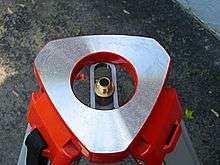Tribrach (instrument)
A tribrach is an attachment plate used to attach a surveying instrument, for example a theodolite, total station, GNSS antenna or target to a tripod. A tribrach allows the survey instrument to be repeatedly placed in the same position with sub-millimetre precision, by just loosening and re-tightening a locking handle or lever.
Components of a tribrach


The device consists of two triangular metal plates connected at their corners by leveling thumbscrews, a bubble level, a locking mechanism and often an optical plummet. The centre of the bottom plate of the tribrach has a 5/8-11 UNC thread bolt hole which is used to attach the tribrach to the tripod. The top plate of the tribrach has three small holes or slots spaced at 120 degrees above leveling thumbscrews, and a locking mechanism which enables a survey instrument to be placed on the tribrach and locked in place.
Some modern total stations have a laser plummet which allows the instrument to be levelled and positioned vertically over a survey monument or ground control point. Other tribrachs have an optical plummet with either a bullseye or cross hair sight for positioning the instrument. The oldest tribrachs required a plumb line to allow them to be positioned vertically over a point and were slower to set up.
Using a tribrach
The tribrach is attached to the tripod and placed over the monument. Looking through the optical plummet pick up two of the tripod legs and position the cross hairs over the monument. Tread all three legs into the grass, bitumen, concrete. Look through the optical plummet and using the thumbscrews put the cross hairs back over the monument. Adjust the level of the tribrach by slackening the tripod screws and sliding the legs. Re-center the cross hairs using the thumb screws, then fine-tune the level using the tripod legs. Once the tribrach is nearly centered over the monument, level the tribrach the last little bit using the thumbscrews. Slacken the tribrach from the tripod head and slide it the last 4-5mm so that it is centered over the monument and level. If the target over which the instrument is to be placed is roughly at the same elevation as the tripod feet, the preceding technique is applicable. However, if there is a considerable difference between the elevation of the target and the elevation of the tripod feet, such as when the target is in a deep hole or raised on a shelf or wall, it will not work, as the target will appear to move laterally by a large distance in the optical plummet as the tripod legs are raised or lowered.
Tribrachs are precision instruments and should be checked regularly to ensure they do not become a source of error.
References
- Gerard L'E. Turner, Nineteenth Century Scientific Instruments, Sotheby Publications, 1983, ISBN 0-85667-170-3
- Gerard L'E. Turner, Antique Scientific Instruments, Blandford Press Ltd. 1980, ISBN 0-7137-1068-3
- US 5501018, Sonney J. Porter, "Tribrach device", published March 26. 1996